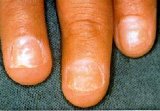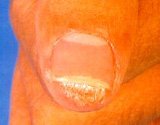
Fig.2 Fungal infection of the nail.

Fig.3 Viral wart infection of the distal nail fold.
The commonest nail infection is fungal nail infection. Fungal nail infection can affect the finger and toe nails.
The infection reaches the nail plate from the free margin and sides of the nails. The nail plate may become brittle, thickened or completely destroyed.
Fungal nail infection can be confirmed by laboratory microscopic examination of clippings of the nail.
Oral antifungal tablets, or antifungal lotion may be prescribed by your doctor for treatment. Treatment may last from 2 to 12 months depending on the type of infection and the oral antifungal tablets prescribed. However, the nail may take as long as a few months to return to near normal appearance even after the treatment has been stopped.
Another common nail disorder is caused by viral wart infection of the nail fold and nail bed. The condition is called periungual viral warts. This condition is best treated by laser surgery.